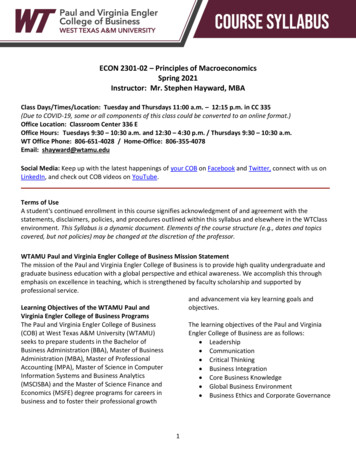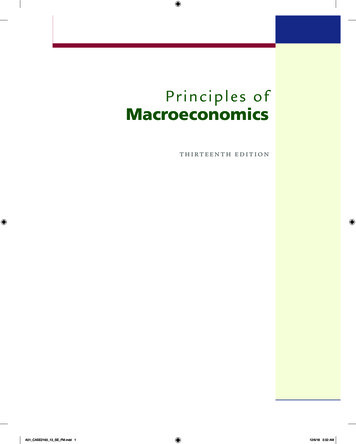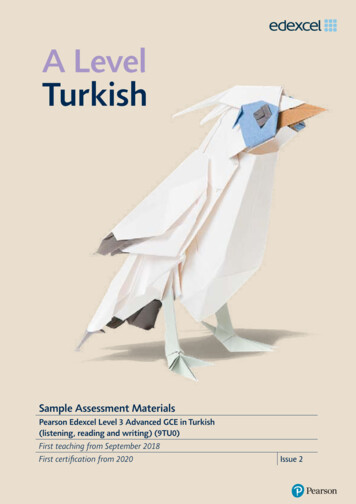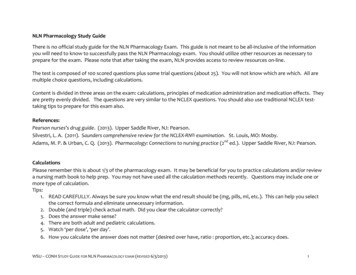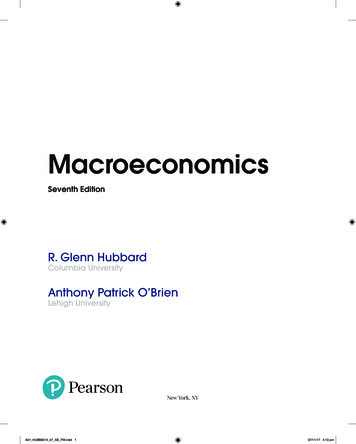
Transcription
MacroeconomicsSeventh EditionR. Glenn HubbardColumbia UniversityAnthony Patrick O’BrienLehigh UniversityNew York, NYA01 HUBB8314 07 SE FM.indd 107/11/17 4:13 pm
Vice President, Business, Economics, and UK Courseware: Donna BattistaDirector of Portfolio Management: Adrienne D’AmbrosioSpecialist Portfolio Manager: David AlexanderDevelopment Editor: Lena BuonannoEditorial Assistant: Nicole NedwidekVice President, Product Marketing: Roxanne McCarleySenior Product Marketer: Tricia MurphyProduct Marketing Assistant: Marianela SilvestriManager of Field Marketing, Business Publishing: Adam GoldsteinSenior Field Marketing Manager: Carlie MarvelVice President, Production and Digital Studio, Arts and Business:Etain O’DeaDirector of Production, Business: Jeff HolcombManaging Producer, Business: Alison KalilContent Producer: Christine DonovanOperations Specialist: Carol MelvilleDesign Lead: Kathryn FootManager, Learning Tools: Brian SuretteContent Developer, Learning Tools: Sarah PetersonManaging Producer, Digital Studio and GLP, Media Productionand Development: Ashley SantoraManaging Producer, Digital Studio: Diane LombardoDigital Studio Producer: Melissa HonigDigital Studio Producer: Alana ColesDigital Content Team Lead: Noel LotzDigital Content Project Lead: Courtney KamaufProject Manager: Heidi Allgair, Cenveo Publisher ServicesInterior Design: Cenveo Publisher ServicesCover Design: Studio MontageCover Photos: Phant/Shutterstock; Mariyana M/ShutterstockPrinter/Binder: LSC Communications, Inc./KendallvilleCover Printer: Phoenix Color/HagerstownMicrosoft and/or its respective suppliers make no representations about the suitability of the information contained in the documents and relatedgraphics published as part of the services for any purpose. All such documents and related graphics are provided “as is” without warranty of any kind.Microsoft and/or its respective suppliers hereby disclaim all warranties and conditions with regard to this information, including all warranties andconditions of merchantability, whether express, implied or statutory, fitness for a particular purpose, title and non-infringement. In no event shallMicrosoft and/or its respective suppliers be liable for any special, indirect or consequential damages or any damages whatsoever resulting from loss ofuse, data or profits, whether in an action of contract, negligence or other tortious action, arising out of or in connection with the use or performanceof information available from the services.The documents and related graphics contained herein could include technical inaccuracies or typographical errors. Changes are periodically addedto the information herein. Microsoft and/or its respective suppliers may make improvements and/or changes in the product(s) and/or the program(s)described herein at any time. Partial screen shots may be viewed in full within the software version specified.Microsoft and Windows are registered trademarks of the Microsoft Corporation in the U.S.A. and other countries. This book is not sponsored orendorsed by or affiliated with the Microsoft Corporation.Copyright 2019, 2017, 2015 by Pearson Education, Inc. or its affiliates. All Rights Reserved. Manufactured in the United States of America. Thispublication is protected by copyright, and permission should be obtained from the publisher prior to any prohibited reproduction, storage in a retrievalsystem, or transmission in any form or by any means, electronic, mechanical, photocopying, recording, or otherwise. For information regardingpermissions, request forms, and the appropriate contacts within the Pearson Education Global Rights and Permissions department, please s of third-party content appear on the appropriate page within the text.PEARSON, ALWAYS LEARNING, and MYLAB are exclusive trademarks owned by Pearson Education, Inc. or its affiliates in the U.S. and/or othercountries.Unless otherwise indicated herein, any third-party trademarks, logos, or icons that may appear in this work are the property of their respective owners,and any references to third-party trademarks, logos, icons, or other trade dress are for demonstrative or descriptive purposes only. Such referencesare not intended to imply any sponsorship, endorsement, authorization, or promotion of Pearson’s products by the owners of such marks, or anyrelationship between the owner and Pearson Education, Inc., or its affiliates, authors, licensees, or distributors.Library of Congress Cataloging-in-Publication Data.Names: Hubbard, R. Glenn, author. O’Brien, Anthony Patrick, author.Title: Macroeconomics / R. Glenn Hubbard, Columbia University, AnthonyPatrick O’Brien, Lehigh University.Description: Seventh Edition. New York : Pearson, [2018] Revised editionof the authors’ Macroeconomics, [2017] Includes index.Identifiers: LCCN 2017050532 ISBN 9780134738314 ISBN 0134738314Subjects: LCSH: Macroeconomics.Classification: LCC HB172.5 .H86 2018 DDC 339—dc23LC record available at https://lccn.loc.gov/2017050532ISBN 10: 0-13-473831-4ISBN 13: 978-0-13-473831-4A01 HUBB8314 07 SE FM.indd 207/11/17 4:14 pm
For Constance, Raph, and Will—R. Glenn HubbardFor Cindy, Matthew, Andrew, and Daniel—Anthony Patrick O’BrienA01 HUBB8314 07 SE FM.indd 307/11/17 4:14 pm
A01 HUBB8314 07 SE FM.indd 407/11/17 4:14 pm
ABOUT THE AUTHORSGlenn Hubbard, policymaker, professor, andresearcher. R. Glenn Hubbard is the dean and Russell L.Carson Professor of Finance and Economics in the GraduateSchool of Business at Columbia University and professor ofeconomics in Columbia’s Faculty of Arts and Sciences. He is also aresearch associate of the National Bureau of Economic Researchand a director of Automatic Data Processing, Black Rock ClosedEnd Funds, and MetLife. He received a PhD in economics fromHarvard University in 1983. From 2001 to 2003, he served as chairof the White House Council of Economic Advisers and chair of theOECD Economic Policy Committee, and from 1991 to 1993, he was deputy assistantsecretary of the U.S. Treasury Department. He currently serves as co-chair of thenonpartisan Committee on Capital Markets Regulation. Hubbard’s fields of specializationare public economics, financial markets and institutions, corporate finance,macroeconomics, industrial organization, and public policy. He is the author of more than100 articles in leading journals, including American Economic Review, Brookings Papers onEconomic Activity, Journal of Finance, Journal of Financial Economics, Journal of Money, Credit, andBanking, Journal of Political Economy, Journal of Public Economics, Quarterly Journal of Economics,RAND Journal of Economics, and Review of Economics and Statistics. His research has beensupported by grants from the National Science Foundation, the National Bureau ofEconomic Research, and numerous private foundations.Tony O’Brien, award-winning professor andresearcher. Anthony Patrick O’Brien is a professor ofeconomics at Lehigh University. He received a PhD from theUniversity of California, Berkeley, in 1987. He has taught principlesof economics for more than 20 years, in both large sections andsmall honors classes. He received the Lehigh University Award forDistinguished Teaching. He was formerly the director of theDiamond Center for Economic Education and was named a DanaFoundation Faculty Fellow and Lehigh Class of 1961 Professor ofEconomics. He has been a visiting professor at the University ofCalifornia, Santa Barbara, and the Graduate School of Industrial Administration at CarnegieMellon University. O’Brien’s research has dealt with issues such as the evolution of the U.S.automobile industry, the sources of U.S. economic competitiveness, the development ofU.S. trade policy, the causes of the Great Depression, and the causes of black–white incomedifferences. His research has been published in leading journals, including American EconomicReview, Quarterly Journal of Economics, Journal of Money, Credit, and Banking, Industrial Relations,Journal of Economic History, and Explorations in Economic History. His research has beensupported by grants from government agencies and private foundations.vA01 HUBB8314 07 SE FM.indd 507/11/17 4:14 pm
BRIEF CONTENTSPrefaceA Word of ThanksP-1P-25Chapter 12: Aggregate Expenditure and Output inthe Short RunPART 1 IntroductionChapter 1: Economics: Foundations and ModelsAppendix: Using Graphs and Formulas228Chapter 2: Trade-offs, Comparative Advantage,and the Market System40Chapter 3: Where Prices Come From: The Interaction ofDemand and Supply72Chapter 4: Economic Efficiency, Government PriceSetting, and TaxesAppendix: Quantitative Demand and Supply AnalysisChapter 5: The Economics of Health Care108392Appendix: The Algebra of MacroeconomicEquilibrium434Chapter 13: Aggregate Demand and AggregateSupply Analysis436Appendix: Macroeconomic Schools of Thought474PART 5 Monetary and Fiscal Policy141Chapter 14: Money, Banks, and the Federal ReserveSystem478146Chapter 15: Monetary Policy516Chapter 16: Fiscal Policy560PART 2 Firms in the Domestic andInternational EconomiesAppendix: A Closer Look at the MultiplierChapter 17: Inflation, Unemployment, and FederalReserve PolicyChapter 6: Firms, the Stock Market, and CorporateGovernance180Appendix: Tools to Analyze Firms’ FinancialInformation206Chapter 7: Comparative Advantage and the Gains fromInternational TradePART 4 Short-Run Fluctuations216PART 3 Macroeconomic Foundationsand Long-Run GrowthChapter 8: GDP: Measuring Total Productionand Income252Chapter 9: Unemployment and Inflation278Chapter 10: Economic Growth, the Financial System,and Business Cycles318Chapter 11: Long-Run Economic Growth: Sourcesand Policies352605610PART 6 The International EconomyChapter 18: Macroeconomics in an Open Economy644Chapter 19: The International Financial System674Appendix: The Gold Standard and the BrettonWoods SystemGlossaryCompany IndexSubject IndexCredits697G-1I-1I-3C-1viA01 HUBB8314 07 SE FM.indd 607/11/17 4:14 pm
CONTENTSPrefaceA Word of ThanksP-1P-25PART 1 IntroductionCHAPTER 1: Economics: Foundationsand ModelsWhy Does Ford Assemble Cars in Both theUnited States and Mexico?1.1 Three Key Economic IdeasPeople Are RationalPeople Respond to Economic IncentivesApply the Concept: Does Health InsuranceGive People an Incentive to Become Obese?Optimal Decisions Are Made at the MarginSolved Problem 1.1: The Marginal Benefit andMarginal Cost of Speed Limits1.2 The Economic Problem That Every SocietyMust SolveWhat Goods and Services Will Be Produced?How Will the Goods and Services Be Produced?Who Will Receive the Goods and Services Produced?Centrally Planned Economies versus MarketEconomiesThe Modern “Mixed” EconomyEfficiency and Equity1.3 Economic ModelsThe Role of Assumptions in Economic ModelsForming and Testing Hypotheses inEconomic ModelsPositive and Normative AnalysisDon’t Let This Happen to You: Don’t ConfusePositive Analysis with Normative AnalysisEconomics as a Social ScienceApply the Concept: What Can EconomicsContribute to the Debate over Tariffs?1.4 Microeconomics and Macroeconomics1.5 Economic Skills and Economics as a Career1.6 A Preview of Important Economic TermsConclusionAn Inside Look: Is Manufacturing Returning tothe United States?*Chapter Summary and 22Key Terms, Summary, Review Questions, Problems andApplications, and Critical Thinking ExercisesAppendix: Using Graphs and FormulasGraphs of One Variable2829Graphs of Two VariablesSlopes of LinesTaking into Account More Than Two Variableson a GraphPositive and Negative RelationshipsDetermining Cause and EffectAre Graphs of Economic RelationshipsAlways Straight Lines?Slopes of Nonlinear CurvesFormulasFormula for a Percentage ChangeFormulas for the Areas of a Rectangle anda TriangleSummary of Using FormulasProblems and Applications303132323435353637373838CHAPTER 2: Trade-offs, ComparativeAdvantage, and the Market System40Managers at Tesla Motors Face Trade-offs2.1 Production Possibilities Frontiers andOpportunity CostsGraphing the Production Possibilities FrontierSolved Problem 2.1: Drawing a ProductionPossibilities Frontier for Tesla MotorsIncreasing Marginal Opportunity CostsEconomic Growth2.2 Comparative Advantage and TradeSpecialization and Gains from TradeAbsolute Advantage versus ComparativeAdvantageComparative Advantage and the Gains from TradeDon’t Let This Happen to You: Don’t ConfuseAbsolute Advantage and ComparativeAdvantageSolved Problem 2.2: Comparative Advantage andthe Gains from TradeApply the Concept: Comparative Advantage,Opportunity Cost, and Housework2.3 The Market SystemThe Circular Flow of IncomeThe Gains from Free MarketsThe Market MechanismApply the Concept: A Story of the Market Systemin Action: How Do You Make an iPad?The Role of the Entrepreneur in the Market SystemThe Legal Basis of a Successful Market SystemApply the Concept: Managers at FeedingAmerica Use the Market Mechanism toReduce Hunger404242444647484850515152535455565657595962* These end-of-chapter resource materials repeat in all chapters. Select chapters also include Real-Time Data Exercises.Students can complete all questions, problems, and exercises in MyLab Economics.viiA01 HUBB8314 07 SE FM.indd 707/11/17 4:14 pm
viiiCONTENTSConclusionAn Inside Look: Tesla Bets Big on Nevada BatteryPlantChapter Summary and ProblemsCHAPTER 3: Where Prices Come From:The Interaction of Demand and Supply63646672How Smart Is Your Water?723.1 The Demand Side of the Market74Demand Schedules and Demand Curves74The Law of Demand75What Explains the Law of Demand?75Holding Everything Else Constant: The Ceteris ParibusCondition76Variables That Shift Market Demand76Apply the Concept: Virtual Reality Headsets:Will a Substitute Fail for a Lack ofComplements?77Apply the Concept: Millennials Shake Up theMarkets for Soda, Groceries, Big Macs, andRunning Shoes78A Change in Demand versus a Change inQuantity Demanded81Apply the Concept: Forecasting the Demand forPremium Bottled Water813.2 The Supply Side of the Market82Supply Schedules and Supply Curves83The Law of Supply83Variables That Shift Market Supply83A Change in Supply versus a Change inQuantity Supplied863.3 Market Equilibrium: Putting Demand andSupply Together86How Markets Eliminate Surplusesand Shortages87Demand and Supply Both Count88Solved Problem 3.3: Demand and Supply BothCount: A Tale of Two Letters883.4 The Effect of Demand and Supply Shifts onEquilibrium90The Effect of Shifts in Demand on Equilibrium90The Effect of Shifts in Supply on Equilibrium90The Effect of Shifts in Demand and Supplyover Time90Apply the Concept: Lower Demand for OrangeJuice—But Higher Prices?92Solved Problem 3.4: Can We Predict Changes inthe Price and Quantity of Organic Corn?94Shifts in a Curve versus Movements along a Curve95Don’t Let This Happen to You: Remember:A Change in a Good’s Price Does Not Causethe Demand or Supply Curve to Shift96Conclusion97An Inside Look: McDonald’s Looks forNew Ways to Attract Customers98Chapter Summary and Problems100A01 HUBB8314 07 SE FM.indd 8CHAPTER 4: Economic Efficiency,Government Price Setting, and TaxesWhat Do Food Riots in Venezuela and the Rise ofUber in the United States Have in Common?4.1 Consumer Surplus and Producer SurplusConsumer SurplusApply the Concept: The Consumer Surplusfrom UberProducer SurplusWhat Consumer Surplus and Producer SurplusMeasure4.2 The Efficiency of Competitive MarketsMarginal Benefit Equals Marginal Cost inCompetitive EquilibriumEconomic SurplusDeadweight LossEconomic Surplus and Economic Efficiency4.3 Government Intervention in the Market:Price Floors and Price CeilingsPrice Floors: Government Policy in AgriculturalMarketsApply the Concept: Price Floors in Labor Markets:The Debate over Minimum Wage PolicyPrice Ceilings: Government Rent Control Policy inHousing MarketsDon’t Let This Happen to You: Don’t Confuse“Scarcity” with “Shortage”Black Markets and Peer-to-Peer SitesSolved Problem 4.3: What’s the EconomicEffect of a Black Market in RentingApartments?The Results of Government Price Controls:Winners, Losers, and InefficiencyApply the Concept: Price Controls Lead toEconomic Decline in VenezuelaPositive and Normative Analysis of Price Ceilingsand Price Floors4.4 The Economic Effect of TaxesThe Effect of Taxes on Economic EfficiencyTax Incidence: Who Actually Pays a Tax?Solved Problem 4.4: When Do ConsumersPay All of a Sales Tax Increase?Apply the Concept: Is the Burden of the SocialSecurity Tax Really Shared Equally betweenWorkers and Firms?ConclusionAn Inside Look: Will Uber Be Required to PayBritish VAT?Chapter Summary and ProblemsAppendix: Quantitative Demand and SupplyAnalysisDemand and Supply EquationsCalculating Consumer Surplus andProducer SurplusReview QuestionsProblems and 3414114114214414407/11/17 4:14 pm
CONTENTSCHAPTER 5: The Economics of Health Care146Where Will You Find Health Insurance?5.1 The Improving Health of People in theUnited StatesChanges over Time in U.S. HealthReasons for Long-Run Improvements in U.S.Health5.2 Health Care around the WorldThe U.S. Health Care SystemApply the Concept: The Increasing Importanceof Health Care in the U.S. EconomyThe Health Care Systems of Canada, Japan, and theUnited KingdomComparing Health Care Outcomes aroundthe WorldHow Useful Are Cross-Country Comparisons ofHealth Outcomes?5.3 Information Problems and Externalities in theMarket for Health CareAdverse Selection and the Market for “Lemons”Asymmetric Information in the Market for HealthInsuranceDon’t Let This Happen to You: Don’t ConfuseAdverse Selection with Moral HazardExternalities in the Market for Health CareShould the Government Run the HealthCare System?5.4 The Debate over Health Care Policy in theUnited StatesThe Rising Cost of Health CareApply the Concept: Are U.S. Firms Handicappedby Paying for Their Employees’Health Insurance?Explaining Increases in Health Care SpendingThe Continuing Debate over Health Care PolicySolved Problem 5.4: Recent Trends in U.S.Health CareApply the Concept: How Much Is ThatMRI Scan?ConclusionChapter Summary and 159161162162164165168169171173174PART 2 Firms in the Domestic andInternational EconomiesCHAPTER 6: Firms, the Stock Market, andCorporate GovernanceIs Snapchat the Next Facebook . . . or theNext Twitter?6.1 Types of FirmsWho Is Liable? Limited and UnlimitedLiabilityCorporations Earn the Majority of Revenue andProfitsA01 HUBB8314 07 SE FM.indd 9180180182182183Apply the Concept: Why Are Fewer YoungPeople Starting Businesses?The Structure of Corporations and thePrincipal–Agent Problem6.2 How Firms Raise FundsSources of External FundsApply the Concept: The Rating Game: Are theFederal Government or State GovernmentsLikely to Default on Their Bonds?Stock and Bond Markets Provide Capital—andInformationThe Fluctuating Stock MarketDon’t Let This Happen to You: When SnapShares Are Sold, Snap Doesn’t Getthe MoneyApply the Concept: Why Are Many People PoorStock Market Investors?Solved Problem 6.2: Why Does Warren BuffettLike Mutual Funds?6.3 Using Financial Statements to Evaluate aCorporationThe Income StatementThe Balance Sheet6.4 Recent Issues in Corporate Governance PolicyThe Accounting Scandals of the Early 2000sCorporate Governance and the Financial Crisis of2007–2009Government Regulation in Response to theFinancial CrisisDid Principal–Agent Problems Help Cause the2007–2009 Financial Crisis?Apply the Concept: Should Investors Worryabout Corporate Governance at Snapchat?ConclusionChapter Summary and ProblemsAppendix: Tools to Analyze Firms’ FinancialInformationUsing Present Value to Make Investment DecisionsSolved Problem 6A.1: How to Receive YourContest WinningsUsing Present Value to Calculate Bond PricesUsing Present Value to Calculate Stock PricesA Simple Formula for Calculating Stock PricesGoing Deeper into Financial StatementsAnalyzing Income StatementsAnalyzing Balance SheetsReview QuestionsProblems and 2212214214CHAPTER 7: Comparative Advantage and theGains from International Trade216President Trump, Oreo Cookies, and Free Trade7.1 The United States in the InternationalEconomyThe Importance of Trade to the U.S. EconomyU.S. International Trade in a World Context21621821922007/11/17 4:14 pm
xCONTENTS7.2 Comparative Advantage in International TradeA Brief Review of Comparative AdvantageComparative Advantage and Absolute Advantage7.3 How Countries Gain from InternationalTradeIncreasing Consumption through TradeSolved Problem 7.3: The Gains from TradeWhy Don’t We See Complete Specialization?Does Anyone Lose as a Result of InternationalTrade?Don’t Let This Happen to You: RememberThat Trade Creates Both Winners and LosersApply the Concept: Who Gains and Who Losesfrom U.S. Trade with China?Where Does Comparative AdvantageCome From?7.4 Government Policies That RestrictInternational TradeTariffsQuotas and Voluntary Export RestraintsMeasuring the Economic Effect of theSugar QuotaSolved Problem 7.4: Measuring the EconomicEffect of a QuotaThe High Cost of Preserving Jobs with Tariffsand QuotasApply the Concept: Smoot-Hawley, the Politicsof Tariffs, and the Cost of Protecting aVanishing IndustryGains from Unilateral Elimination of Tariffsand QuotasOther Barriers to Trade7.5 The Debate over Trade Policies andGlobalizationWhy Do Some People Oppose the World TradeOrganization?Apply the Concept: Protecting Consumer Healthor Protecting U.S. Firms from Competition?DumpingPositive versus Normative Analysis (Once Again)ConclusionChapter Summary and 232234235235237237237237240241241242243PART 3 Macroeconomic Foundationsand Long-Run GrowthCHAPTER 8: GDP: Measuring Total Productionand Income252The Ford Motor Company Meets Macroeconomics8.1 Gross Domestic Product Measures TotalProductionMeasuring Total Production: Gross DomesticProductSolved Problem 8.1: Calculating GDPProduction, Income, and the Circular-Flow Diagram252A01 HUBB8314 07 SE FM.indd 10255255256256Components of GDPDon’t Let This Happen to You: RememberWhat Economists Mean by InvestmentAn Equation for GDP and Some Actual ValuesApply the Concept: Microsoft’s Steve BallmerUses the U.S. Constitution to ReorganizeGovernment DataMeasuring GDP Using the Value-Added Method8.2 Does GDP Measure What We Want Itto Measure?Shortcomings in GDP as a Measure of TotalProductionApply the Concept: Why Do Many DevelopingCountries Have Such Large UndergroundEconomies?Shortcomings of GDP as a Measure ofWell-Being8.3 Real GDP versus Nominal GDPCalculating Real GDPSolved Problem 8.3: Calculating Real GDPComparing Real GDP and Nominal GDPThe GDP DeflatorApply the Concept: Did the Standard of Livingin Nigeria Almost Double Overnight?8.4 Other Measures of Total Production andTotal IncomeGross National ProductNational IncomePersonal IncomeDisposable Personal IncomeThe Division of IncomeConclusionChapter Summary and Problems269269269270270270271272CHAPTER 9: Unemployment and Inflation278Why Would Boeing Cut Thousands of Jobs As theEconomy Expands?9.1 Measuring the Unemployment Rate, theLabor Force Participation Rate, and theEmployment–Population RatioThe Household SurveySolved Problem 9.1: What Happens if the BLSIncludes the Military?Problems with Measuring the UnemploymentRateTrends in Labor Force ParticipationUnemployment Rates for Different GroupsHow Long Are People Typically Unemployed?Apply the Concept: Eight Million WorkersAre Missing!The Establishment Survey: Another Measure ofEmploymentRevisions in the Establishment SurveyEmployment Data: How Bad Was the 2007–2009Recession?Job Creation and Job Destruction over 7828028028228328428528628628828928907/11/17 4:14 pm
CONTENTS9.2 Types of UnemploymentFrictional Unemployment and Job SearchStructural UnemploymentCyclical UnemploymentFull EmploymentApply the Concept: How Should We Categorizethe Unemployment Resulting from Boeing’sLayoffs?9.3 Explaining UnemploymentGovernment Policies and the Unemployment RateLabor UnionsEfficiency Wages9.4 Measuring InflationThe Consumer Price IndexIs the CPI Accurate?Don’t Let This Happen to You: Don’t Miscalculatethe Inflation RateThe Producer Price Index9.5 Using Price Indexes to Adjust for the Effectsof InflationSolved Problem 9.5: What Has Been Happeningto Real Wages in the United States?9.6 Nominal Interest Rates versus Real InterestRates9.7 Does Inflation Impose Costs on the Economy?Inflation Affects the Distribution of IncomeThe Problem with Anticipated InflationThe Problem with Unanticipated InflationApply the Concept: What’s So Bad aboutFalling Prices?ConclusionChapter Summary and 298298299301302303303304304306307CHAPTER 10: Economic Growth, the FinancialSystem, and Business Cycles318Economic Growth and the Business Cycle atChevron Corporation10.1 Long-Run Economic GrowthApply the Concept: The Connection betweenEconomic Prosperity and HealthCalculating Growth Rates and the Rule of 70What Determines the Rate of Long-Run Growth?Solved Problem 10.1: Where Does ProductivityCome From?Apply the Concept: Can India Sustain Its RapidGrowth?Potential GDP10.2 Saving, Investment, and theFinancial SystemAn Overview of the Financial SystemThe Macroeconomics of Saving and InvestmentThe Market for Loanable FundsApply the Concept: Ebenezer Scrooge: AccidentalPromoter of Economic Growth?Solved Problem 10.2: Are Future Budget Deficitsa Threat to the Economy?A01 HUBB8314 07 SE FM.indd 11318320321323324325326328329329330332333335xi10.3 The Business CycleSome Basic Business Cycle DefinitionsHow Do We Know When the Economy Is in aRecession?What Happens during the Business Cycle?Don’t Let This Happen to You: Don’t Confusethe Price Level and the Inflation RateWill the U.S. Economy Return to Stability?ConclusionChapter Summary and Problems341344345346CHAPTER 11: Long-Run Economic Growth:Sources and Policies352What Explains Slow Growth in Mexico?11.1 Economic Growth over Time and aroundthe WorldEconomic Growth from 1,000,000 b.c.e. to thePresentApply the Concept: Why Did the IndustrialRevolution Begin in England?Small Differences in Growth Rates Are ImportantWhy Do Growth Rates Matter?Don’t Let This Happen to You: Don’t Confuse theAverage Annual Percentage Change with theTotal Percentage Change“The Rich Get Richer and ”Apply the Concept: Is Income All That Matters?11.2 What Determines How Fast EconomiesGrow?The Per-Worker Production FunctionWhich Is More Important for Economic Growth:More Capital or Technological Change?Technological Change: The Key to SustainingEconomic GrowthApply the Concept: What Explains the EconomicFailure of the Soviet Union?Solved Problem 11.2: Using the EconomicGrowth Model to Analyze the Failure of theSoviet EconomyNew Growth TheoryJoseph Schumpeter and Creative Destruction11.3 Economic Growth in the United StatesEconomic Growth in the United States since 1950Is the United States Headed for a Long Period ofSlow Growth?11.4 Why Isn’t the Whole World Rich?Catch-up: Sometimes but Not AlwaysSolved Problem 11.4: The Economic GrowthModel’s Prediction of Catch-UpWhy Haven’t Most Western European Countries,Canada, and Japan Caught Up to the United States?Why Don’t More Low-Income CountriesExperience Rapid Growth?Apply the Concept: Why Hasn’t Mexico Grownas Fast as China?The Benefits of 37637807/11/17 4:14 pm
xiiCONTENTS11.5 Growth PoliciesEnhancing Property Rights and the Rule of LawApply the Concept: Will China’s Standard ofLiving Ever Exceed That of theUnited States?Improving Health and EducationPolicies That Promote Technological ChangePolicies That Promote Saving and InvestmentIs Economic Growth Good or Bad?ConclusionChapter Summary and Problems379379379381381381382383384CHAPTER 13: Aggregate Demand andAggregate Supply AnalysisPART 4 Short-Run FluctuationsCHAPTER 12: Aggregate Expenditure andOutput in the Short RunFluctuating Demand Helps—and Hurts—Intel andOther Firms12.1 The Aggregate Expenditure ModelAggregate ExpenditureThe Difference between Planned Investment andActual InvestmentMacroeconomic EquilibriumAdjustments to Macroeconomic Equilibrium12.2 Determining the Level of AggregateExpenditure in the EconomyConsumptionThe Relationship between Consumption andNational IncomeIncome, Consumption, and SavingSolved Problem 12.2: Calculating the MarginalPropensity to Consume and the MarginalPropensity to SavePlanned InvestmentApply the Concept: Is Student Loan DebtCausing Fewer Young People toBuy Houses?Government PurchasesNet ExportsApply the Concept: The iPhone Is Made inChina . . . or Is It?12.3 Graphing Macroeconomic EquilibriumShowing a Recession on the 45 -Line DiagramThe Important Role of InventoriesA Numerical Example of MacroeconomicEquilibriumDon’t Let This Happen to You: Don’t ConfuseAggregate Expenditure with ConsumptionSpendingSolved Problem 12.3: DeterminingMacroeconomic Equilibrium12.4 The Multiplier EffectApply the Concept: The Multiplier in Reverse:The Great Depression of the 1930sA Formula for the MultiplierA01 HUBB8314 07 SE FM.indd 12Summarizing the Multiplier EffectSolved Problem 12.4: Using the MultiplierFormulaThe Paradox of Thrift12.5 The Aggregate Demand CurveConclusionChapter Summary and ProblemsAppendix: The Algebra of MacroeconomicEquilibriumReview 5407408410410414415415416416417420421The Fortunes of KB Home Follow theBusiness Cycle13.1 Aggregate DemandWhy Is the Aggregate Demand Curve DownwardSloping?Shifts of the Aggregate Demand Curve versusMovements along ItThe Variables That Shift the AggregateDemand CurveDon’t Let This Happen to You: UnderstandWhy the Aggregate Demand Curve IsDownward SlopingSolved
Macroeconomics Seventh Edition R. Glenn Hubbard Columbia University Anthony Patrick O’Brien Lehigh University N

